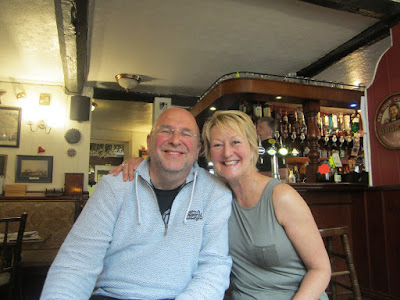'Lovely fresh dreams. First-class nightmares. We got 'em. Get yer
lovely nightmares here.'
'Weapons! Arm yourself! Defend your cellar, cave, or hole! You want to
hit 'em? We got 'em. Come on darling, come on over here ... '
'Rubbish!' screamed a fat, elderly woman, in Richard's ear, as he
passed her malodorous stall. 'Junk!' she continued. 'Garbage! Trash! Offal!
Debris! Come and get it! Nothing whole or undamaged! Crap, tripe, and useless
piles of shit. You know you want it.'
No, not the Floating Market in the London Below of Neil Gaiman's Neverwhere; this one was on the Kennet and Avon canal in Bradford-on-Avon.
And we weren't forced to venture over Night's Bridge to get there either.
Though having parked at Avoncliff, we did have to cross the aqueduct over the River Avon, but it wasn't anywhere near as dark or scary.
We then had a pleasant wander the mile and a half or so along the canal to the lock at Bradford on Avon.
 The throng of people on the towpath started to thicken by the tithe barn so I decided to sit with Ted, who, like many collies, is averse to crowds, in the adjoining field while the Northerner went on to sample wares.
The throng of people on the towpath started to thicken by the tithe barn so I decided to sit with Ted, who, like many collies, is averse to crowds, in the adjoining field while the Northerner went on to sample wares.
The juxtaposition of Civil War Re-Enacters with members of the public made for some interesting vignettes. It all looked quite convincing ...
... or portaloos.
 The Northerner came back to say that it wasn't as crowded as he'd feared so Ted and I ventured back up onto the towpath.
The Northerner came back to say that it wasn't as crowded as he'd feared so Ted and I ventured back up onto the towpath.
Alongside were Chris and Jinny of Skyravenwolf and I was vexed when I got home to discover that I'd been so busy chatting to them that I hadn't taken any pictures of their work, and I can't photograph the things I bought because they're presents for people who might read this blog. But here's a link to their Facebook page. Such stunning work! I'm on their waiting list for a present for the Northerner but I think I need to agitate for him to get onto the waiting list for a present for me.
Jinny very kindly checked when the Re-Enacters were due to start firing their cannons in their planned skirmish on the town's mediaeval bridge, and as it was only half an hour away, we decided that for the sake of our noise-sensitive Ted, we'd do well to head back towards Avoncliff and a pint in the Crossed Guns.
















































































